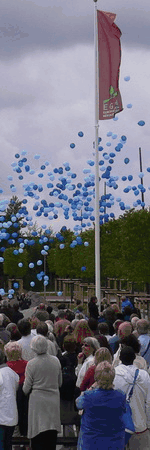Six major workshops were held during the project
13th and 14th JUNE 2012
– Lund / Sweden: “Social Aspects 1”
15th and 15th OCTOBER 2012
– North Rhine-Westphalia / Germany: “Economic Aspects 1”
17th and 18th APRIL 2013
– Paola / Malta: “Environmental Aspects 1”
14th and 15th JUNE 2013
– Turku / Finland: “Economic Aspects 2”
07th and 08th NOVEMBER 2013
– Emilia-Romagna / Italy: “Social Aspects 2”
23rd, 24th and 25th JULY 2014
– Mikolow / Poland: “Environmental Aspects 2”
Workshop “Environmental Aspects 2”, 23.-25. July 2014, Mikolow/Poland
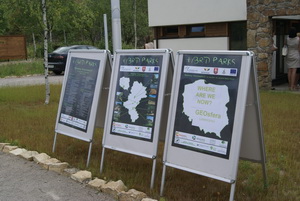 The workshop started at GEOsfera in Jaworzno. This newly opened geological park in a former quarry presents the typical flora and fauna of such sites. Exploitation of limestone revealed the numerous fossils and roughness of the bottom, showing the turbulent history of the place, dating back 260 million years. GEOsfera also aims at attracting garden lovers and those looking for a relaxing day out in the nature, e.g. by an extensive sensory garden.
The workshop started at GEOsfera in Jaworzno. This newly opened geological park in a former quarry presents the typical flora and fauna of such sites. Exploitation of limestone revealed the numerous fossils and roughness of the bottom, showing the turbulent history of the place, dating back 260 million years. GEOsfera also aims at attracting garden lovers and those looking for a relaxing day out in the nature, e.g. by an extensive sensory garden.
The group then visited the new section of the Silesian Botanical Garden with the buildings of the Centre of Ecological Education of Children and the new plant collections. Here Hybrid Parks planted three trees, selected for their distinguishing social, environmental and economic relevance.
At the main site of the Silesian Botanical Garden, a former missile station, other sections related to ecological and environmental education were visited. The workshop continued with a guest expert who presented the aims and recent activities of the European Earth Centre Foundation. In the courtyard, impressive large scale photos from the recent project “Arbores Vitae (Trees of Life)” taken at Bialowieża Primeval Forest, forest were shown. This last European primeval forest is a UNESCO World Heritage Site, a UNESCO Biosphere Reserve, and an EU Natura 2000 Special Area of Conservation. It straddles the border between Poland and Belarus.
After a visit to Ogrody Pokazowe Kapias, a plant nursery with huge variety of perfectly maintained show gardens in Goczałkowice, the second day was continued in Pszczyna, where a good combination of a park with a site of environmental importance was visited: the historic castle park with its demonstrational wisent enclosure. The protection of the wild living wisent was also the focus at the Centre of Wisent Breeding and Forest Education in Jankowice.
Presentations by partners opened the last day of the workshop: about the benefits of regional and European networking for the (economic) revitalisation of historic parks, about subsidies for planting old plant varieties and about the outcomes of the study on the “consideration of climate change in the design of parks and open spaces” commissioned by Hybrid Parks. Local experts informed the group about the Silesia Park and about the Silesian Botanical Garden in Radzionków. These two sites, as well as the historic park in Świerklaniec, were visited in the afternoon. The structures, the variety and the history of the huge Silesia Park, started in the 1950s on a former coal mining site, make it a unique example of a pre-industrial recreational and educational park in the heart of the agglomeration. Finally, on the grounds of the Silesian Botanical Garden in Radzionków, the group explored the successful transfer of biotopes from a building site at Katowice airport to this new and protected location.
Workshop “Social Aspects 2”, 07./08. November 2013, Ferrara/Italy
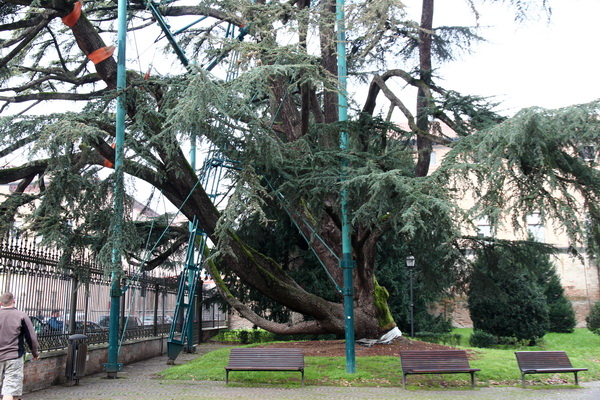 The fifth international workshop of Hybrid Parks focussed on urban agriculture and its benefits from a socio-cultural point of view. It was organized by Emilia-Romagna Region and the Province of Ferrara and hosted in Ferrara, a UNESCO’s World Heritage City that represents a rare example of conservation of rural areas designed in the Middle Age within the historic city walls.
The fifth international workshop of Hybrid Parks focussed on urban agriculture and its benefits from a socio-cultural point of view. It was organized by Emilia-Romagna Region and the Province of Ferrara and hosted in Ferrara, a UNESCO’s World Heritage City that represents a rare example of conservation of rural areas designed in the Middle Age within the historic city walls.
Under its inspirational label or axiom AGOR-AGRO participants explored how green areas such as gardens, vegetable gardens or parks give an important contribution to outline urban and peri-urban landscapes and also do improve the quality of citizens’ life. This was done during discussions in workshops, but also by surveys, guided tours, interventions and presentations provided by horticulture experts at European and local level, including a visit to Portomaggiore and its famous Delizia del Verginese, the ancient residence of the Este Dukes.
The wide range of “gardening” in urban areas in Italy and results of research with its socio-cultural aspects was presented at the beginning of the workshop by Silvia Zucconi and Chiara Volpato
showing the development of “agriculture for leisure” in Italy from hobby to urban farming, by Giorgio Prosdocimi Gianquinto and Giovanni Bazzocchi focussing on the key role of urban horticulture to contribute to fight social exclusion and to promote lifelong learning among adults through community and urban gardening and by Roberta Bartoletti, who spoke about the new season of urban vegetable gardens in the city of Bologna and their role for intergenerational exchanges and environmental sustainability.
As a meaningful intermezzo and reminder of the overall approach of Hybrid Parks, Manfredi Patitucci talked about his idea of hybrid parks and the allegory of good government.
This also opened the scene for information about newer projects from Italy. A presentation by Mariella Carbone and Leonardo Gioffré highlighted the opportunities of therapeutic bio-diversity as given by a combination of nature, landscape, arts and therapy. Next was an introduction to the urban garden project by ANCI Umbria given by Gemma Borzacchini. Then we saw the trailer and some short episodes from the film “God save the green” very successfully produced by: Mammuth Film.
Then and even more during the second workshop on the next day, presentations by European partners added to the range of socio-economic aspects of gardening and gardens. It started with a presentation by Lieselott Johansson and Cecilia Liljedahl on the Skäggetorp project in Linköping and the inclusion of people living in this housing district and also from Sweden by Anders Szczepanski who informed the audience about his long and international working experiences with outdoor training and learning as a place based concept.
The work of keen gardeners of today and in history will soon be shown to a wider audience thanks to the development and promotion of a garden route in Brittany, which was presented by Geoffroy de Longuemar. Then Cecilia Liljedahl invited us to see in her presentation some contemporary urban gardening projects in Sweden, which may become the garden heritage of tomorrow. How this variety of parks and gardens and many other green or open spaces in a city can be managed and developed in an inclusive and sustainable way, was shown on the example of the Green Book for Dortmund by Johannes Blume. Finally Pawel Kojs and Marzena Osmalak presented the Silesian ecological calendar as their innovative and transferable concept for educational activities in the Silesian Botanical Garden.
Workshop “Economic Aspects 2”, 14./15. June 2013, Pori/Finland
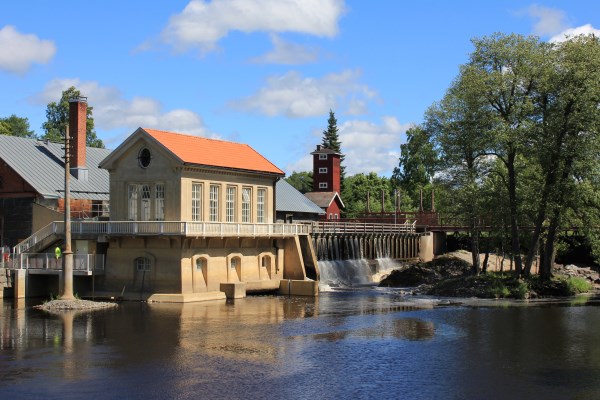
Central to the two day workshop in and around Pori was the Finnish concept of “National Urban Parks – NUP”, an innovative approach to avoid negative effects of densification related to the idea of compact cities.
Today city planners are very well aware of the negative impacts of urban sprawl on the sustainability of cities and towns. For this reason there is a global trend to build more compact cities in the name of sustainability. Densification of urban structure and infill building are today very commonly used in Finnish cities and towns to get more compact urban areas. There can be a risk that the valuable entireties formed together by urban nature, parkland, water areas and built environment, would be shattered by densification and infill building.
The Finnish NUP Concept serves communes as a tool to create more compact cities and town while preserving natural and cultural heritage in their physical environment. The NUP Concept is a part of Land Use and Building Act, which came into force in 1.1.2000. Today there is a network of six NUP Sites in Finland. Some more are under the preparation in the different parts of the country.
The Seminar Day at the University Consortium of Pori started with welcome speech given by Professor Maunu Häyrynen and a General Introduction of National Urban Park (NUP) as the frist presentation by Environment Councellor Jukka-Pekka Flander. In the second presentation the Director of Urban Planning in Pori, Olavi Mäkelä, presented the Pori NUP area that comprises three distinct entities, characterized by island, forest and the city centre. He also mentioned ongoing projects in or close to the NUP area: a new arena and the Housing Fair 2018.
The third presentation “Delta, Natura, National Park – continuation of NUP” by the Director of Pori Environmental Agency Matti Lankiniemi showed the unique estuary nature of Pori with the Kokemäenjoki River delta being is the largest in Nordic countries. The coordination of the NUP in Pori is done by the City Planning Office in cooperation with 1) Environmental Agency 2) Park Office 3) Educational Agency 4) Communications unit 5) Cultural Office and 6) Recreational Agency – which shows the hybrid functions of the area.
The fourth presentation was about the “National Urban Park Process – Making of the Turku NUP”. This NUP was officially established on the 5 June 2013, but had a long genesis. The National Urban Park resolution emphasizes the distinctive cultural and natural urban landscape on the whole and strengthens the vision and ambition to preserve and develop the core of the urban green network. The presentation was given by Jukka-Pekka Flander on behalf of the planner Samuli Saarinen from Turku, who was unable to attend the workshop.
With the fifth presentation by Professor Peter Schantz there was a virtual visit to Sweden. His talk about “The Royal National Urban Park in Stockholm” presented this early NUP as an interesting study object in terms of problems and possibilities in modern city planning, and legal pathways in steering these processes. He presented some principal issues in this respect and also research dealing with a specific aspect of sustainable development, namely public health and the role of green environment in supporting physical activity.
The last three presentations were under title: “Cases of Finnish National Urban Parks” and focused for the Porvoo National Urban Park on cultural heritage management in community processes (Anne Rihtniemi-Rauh, Planner), for the Hämeenlinna National Urban Park on the management and utilization plan as well as marketing (Timo Tuomola, Chief Executive, LinnanInfra) and for the Hanko National Urban Park on its history and the coastal nature and the dialogue between these two (Jukka-Pekka Halme, Head of Office). The day ended with a discussion-workshop on NUP issues such as nature and biodiversity, conservation and long term management.
The Tour Day started with a promenade to the intersecting boulevards, to the City Hall Park, over the Taavi-bridge to Kirjurinluoto with lots of recreation and leisure activities in the park. The Polsanluoto “miniature delta” was explored by using duckboards and a hand-powered ferry. The City Garden Center showed us its floral splendor. Then the bus took us to Noormarkku, nowadays part of Pori (from 2010). Noormarkku is the birthplace of the Ahlstrom Corporation. We visited the Villa Mairea, designed by architect Alvar Aaltoas the private home for Maire and Harry Gullichsen (Ahlstrom family). Then we had a walking tour in Noormarkku Ahlstrom area, the area of the national significant cultural environment and industrial history (pergola, gardens, parks, sawmill).
Our tour continued to the coast and Reposaari village, known for its extraordinary flora as exotic plants invaded the island when the sail ships unloaded the sand used as sailing ballast. With a visit to the magnificent Yyteri beach a great day and a very informative and intense workshop ended.
Workshop “Environmental Aspects 1”, 17./18. April 2013, Paola/Malta
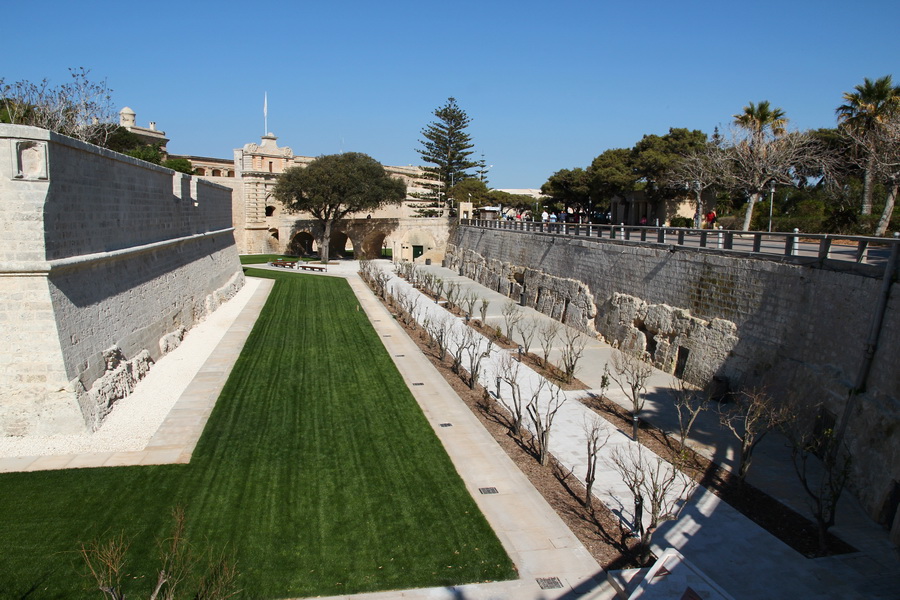 The workshop started with visits to Floriana Gardens and Valletta Gardens. In the Botanical Garden a tour was given by Professor Buhagiar. The on-site discussion included the origins and design of gardens with reference to restoration and conservation and the impact of climate. In the Hastings Garden and the Barracca Garden Malcolm Borg explained the evolution of the British garden as a public space during the Victorian period.
The workshop started with visits to Floriana Gardens and Valletta Gardens. In the Botanical Garden a tour was given by Professor Buhagiar. The on-site discussion included the origins and design of gardens with reference to restoration and conservation and the impact of climate. In the Hastings Garden and the Barracca Garden Malcolm Borg explained the evolution of the British garden as a public space during the Victorian period.
Officially the workshop was inaugurated the next morning by Minister Mizzi who referred to the challenge Malta and the world faces in regard to energy and water, with the current economic scenario and the effects of climate changes. For him Hybrid Parks is as an intelligent way at dealing with future aspirations and citizens’ needs. Then the Vice-Chairman of the Paola Heritage Foundation, Charles Deguara, highlighted the cooperation between the Council and the Foundation with the involvement of Paola citizens in the Urban Support Group and in the compilation of the REPAIR Action Plan launched in 2010. He referred to the AT FORT project looking at fortifications as cultural asset and resourceful open space.
Roderick Spiteri, mayor of Paola, showed the project in the context of the REPAIR Action Plan and its Heritage Trail with parks as an integral part. He also referred to the regeneration of two parks: Gaddafi Gardens and Wied Blandun Garden. In the former a system of Mediterranean gardens inspired by Islamic and Moorish styled gardens has been re-designed with Nature Trust. Wied Blandun is a 80s design and being conceived as an exercising area.
Session 1 of the workshop started with Christian Gruessen presenting the phasing of the Hybrid Parks project and its environmental reference and objectives in a wider policy context. The presentation by MEPA official René Attard traced the various mechanisms in planning to conserve public and private gardens and their context, including typologies and listing. The next presentation by Malcolm Borg highlighted the origins and evolution of gardens with a strong focus on sustainability and rehabilitation, new landscaping and garden design options.
Then Martin Galea of Din l-Art Helwa, a local voluntary organisation, discussed to the various types of sites which the organisations took in trust and is currently managing, such as fortifications, the Msida Bastion Cemetery and the Nature Park, all subject to restoration based on voluntary work. The session continued with a study visit to the Garden of Serenity at Santa Lucia then to Buskett and Mdina. At the Garden of Serenity, the mayor Fredrick Cutajar explained the origin and the plans for the redevelopment of the Chinese Garden. In Mdina the group visited Howard Gardens and the newly designed Ditch Garden or Foss Mdina.
The third day was hosted by The President and started with a tour at the President’s Palace, its private garden and the recently re-opened Kitchen Garden. The afternoon session included various contributions by the partners. It was started by Alina Mzyk on the investments made in Mikolow for the enhancement of the environment, in particular public sites and the Botanical Garden. Pawel Kojs talked about adaptive systems in changing environments, biodiversity and the contribution of the network of botanical gardens in Poland. The Finnish Urban Park Concept as a policy to protect both biodiversity and cultural heritage as well as to ensure blue and green spaces for city dwellers was presented by Anu Tuovinen, also as a preparation to the next workshop. Then Johanna Aaltonen and Jan Tvrdy presented the conversion of the Vuosaari landfill into a park. This best practice case study of an integrated planning approach” following (a) restorative design, (b) ecological design, (c) regenerative development and (d) conventional design will also be available as one of Hybrid Parks best practice case studies soon. The final presentation by Roswitha Arnold gave a short but very succinct overview of how the Landschaftsverband Rheinland implements various garden typologies and innovative landscaping proposals as educational facilities and inspirations to be used in private gardens.
Finally the group visited the nursery and propagation area maintained by the Environmental Landscape Consortium. The officials gave an overview of the landscape and maintenance projects in hand and explained how the consortium in public-private-partnership with the government introduces hardier plant types and indigenous plants into new projects and the design of existing public areas.
- Agenda
- Presentations
- Summarizing Report (in English)
- Newsletter / Report from Emilia-Romagna (in Italian)
- Gallery
- Specific website for this workshop
Workshop “Economic Aspects 1”, 15./16. October 2012, Jüchen/Germany
 The benefits of high quality public green areas and the vital contribution of municipalities, NGOs and other groups in this context are undisputed.
The benefits of high quality public green areas and the vital contribution of municipalities, NGOs and other groups in this context are undisputed.
How a federal state like North Rhine-Westphalia and a regional authority like the Regional Association Ruhr (RVR) can support such provisions and how they use parks and gardens for policies of sustainable development was shown in the presentations by Evamaria Küppers-Ullrich (with a focus on liveable cities in times of economic, demographic and climatic change) and Michael Schwarze-Rodrian (with a focus on the Emscher Landscape Park and the Ruhr as European Capital of Culture 2010).
However, the precise contribution of investments in green infrastructures to economic effects such as the creation of new locations or a new regional image is difficult to be measured. This is where the next presentation started. Prof. Dietwald Gruehn showed models and examples of his research work on land value increasing effects by open spaces in European cities.
How a park itself can be an economic factor, generating income and creating new activities and jobs was shown by Jens Spanjer in his presentation on Schloss Dyck. After the guided tour through the premises of Schloss Dyck, presentations by partners from Poland, Malta, the UK and Germany revealed that the economic effects of investments in parks and gardens can often be combined with social and environmental benefits.
The study trip on the second day brought the group to the Ruhr region. First they visited Phoenix See in Dortmund, where a former steel factory site is transformed into a landscape with a lake, hills, and leisure facilities flanked by high quality housing and business areas. After a stop at one of the many inner city allotment gardens, the day ended with a visit to the famous Landscape Park Duisburg-Nord where remains of the former high furnaces and other industrial remains form a kind of modern follies giving space for many leisure activities and adventures.
Workshop “Social Aspects 1”, 13./14. June 2012, Lund/Sweden
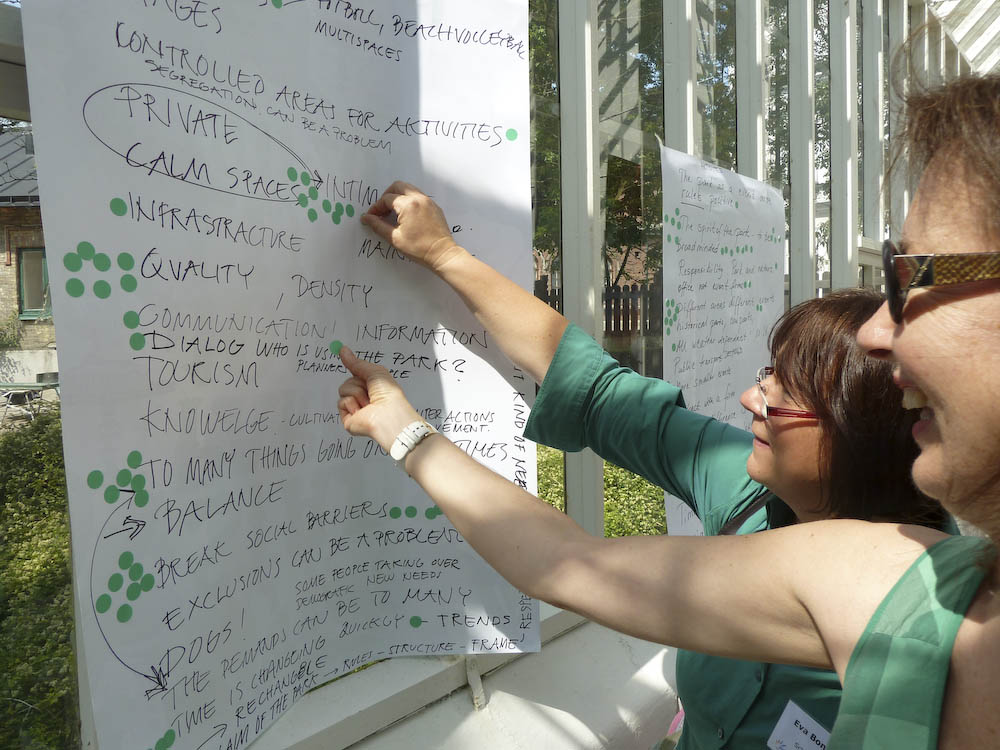 The City Park in Lund was the main venue and also one of the subjects discussed within this workshop in June 2012 focussing on the social dimension of parks and gardens.
The City Park in Lund was the main venue and also one of the subjects discussed within this workshop in June 2012 focussing on the social dimension of parks and gardens.
Founded in 1911, the City Park parkwas always well used, but present-day visitors and urban development required a major redesign and redevelopment. The partners discussed how conflicting user demands, but also different objectives set by heritage conservation (the park includes remains of the ancient city wall), nature protection (the park is a NATURA 2000 site) and modern park design have influenced the new Masterplan (download PDF, 40 MB) and visited the new structures implemented during the first phase of the modernization.
The next day started with a presentation by Prof. Grahn (article available here, 0,6 MB), one of the leading experts for healing (or therapeutic) gardens. The healing garden at Alnarp University was explored then and the advantages and limitations of therapies making use of the unique healing qualities of gardens were discussed in much detail on site.
Central to the visit of Malmö was the guided tour by John Taylor through the Castle Garden. This garden was set up by citizens on a public ground close to the city’s centre. Even today vegetables and flowers are grown here to be used in the garden’s restaurant or to be sold in the plant shop. Modern, designed gardens add to the quality of the place which is a major visitor attraction today but still offers working and training opportunities to many people who have difficulties to find jobs elsewhere.
